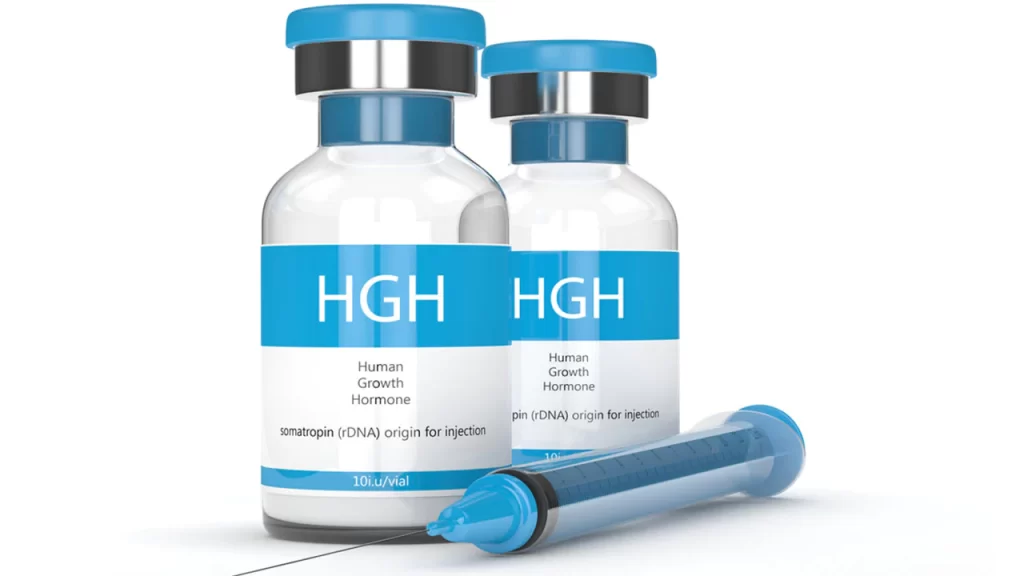Human Growth Hormone (HGH)
Human growth hormone (HGH) is a naturally occurring hormone that your pituitary gland secretes. It helps adults maintain standard body structure, encourages growth in children, and affects both children’s and adults’ metabolism.

What is human growth hormone (HGH)?
Human growth hormone, commonly referred to as HGH and somatotropin, is a naturally occurring hormone that your pituitary gland produces and releases. It has many effects on the body and helps children grow. Although HGH no longer increases height once the growth plates in your bones (epiphyses) have closed, your body still needs HGH. After you’ve finished growing, HGH aids in maintaining proper body composition and metabolism, including assisting in maintaining regular blood sugar (glucose) levels.
Hormones communicate with your organs, muscles, and other tissues through your blood to coordinate various bodily operations. These messages instruct your body on what to do and when. Your body produces over 50 hormones, and many interact with one another to form a complicated web of physiological processes.
Your pituitary gland is a tiny, pea-sized endocrine gland situated underneath your hypothalamus at the base of your brain. The anterior (front) lobe and posterior (rear) lobes are two. Your frontal lobe produces HGH.
A stalk of blood arteries and neurons connects your hypothalamus to your pituitary gland. The pituitary stalk is what it is known as. Your brain’s hypothalamus controls digestion, heart rate, blood pressure, and body temperature. Your hypothalamus instructs your pituitary gland to release particular hormones through the stalk. In this instance, your hypothalamus secretes GHRH, which stimulates the release of HGH from your pituitary gland, and somatostatin, which inhibits (prevents) that release.
Growth hormone deficit is one of the disorders that doctors treat with a synthetic version of HGH, also known as recombinant HGH. Never use synthetic human growth hormone (HGH) without a doctor’s prescription.
What triggers human growth hormone (HGH)?
Throughout the day, your pituitary gland typically releases HGH in brief pulses. Growth hormone-releasing hormone (GHRH), which increases HGH release, and somatostatin, which stops (inhibits) HGH release, are the two hormones that your hypothalamus primarily secrets.
Several more endocrine hormones, such as insulin-like growth factor 1, control human growth hormone (IGF-1). Thyroxine, glucocorticoids, and ghrelin increase the release of HGH, whereas IGF-1 is a significant suppressor of GH synthesis.
One of the impacts of HGH activity that is most understood is the release of IGF-1 by your liver. Through the stimulation of somatostatin and the inhibition of GHRH release, IGF-1 is essential in stopping (inhibiting) the production of HGH. However, there is a feedback relationship between HGH and IGF-1 secretion, with HGH initiating IGF-1 release and IGF-1 inhibiting HGH release. Hyperglycemia (high blood sugar) inhibits HGH secretion in healthy individuals, while hypoglycemia (low blood sugar) and amino acids enhance it.
What role does the human growth hormone (HGH) play?
Human growth hormone primarily affects metabolism and stimulates development, particularly in youngsters (how your body turns the food you eat into energy).
Growth and HGH
Almost all of your body’s tissues and organs begin to expand when the human growth hormone is present. However, it is well known for its role in encouraging bone and cartilage formation, particularly in adolescence during puberty. HGH sends signals to the chondrocyte and osteoblast cells in bones and cartilage to boost replication and promote size growth.
When a child’s growth plates have closed, HGH no longer makes them taller. Instead, HGH supports preserving your body’s regular structure for the remainder of your life.
HGH and metabolism
The chemical processes in your body, known as metabolism, convert the food you eat into energy. Your body’s cells require power to operate correctly. Metabolism entails several intricate mechanisms.
The primary way that HGH affects metabolism is by boosting the body’s production of IGF-1, which impacts cells. IGF-1, a hormone with a structure resembling insulin, controls the effects of HGH in your body. Your pancreas produces insulin, a necessary hormone that lowers your blood sugar (glucose) levels to help prevent them. IGF-1 has similar effects to insulin in decreasing blood sugar.
Your blood glucose levels are generally closely regulated by your body. The primary type of sugar in your blood is called blood glucose or sugar. The carbs in the food you eat provide you with glucose. This sugar gives your body’s organs, muscles, and nervous system nutrition and serves as a significant energy source.
The primary hormones your pancreas produces are insulin and glucagon, which are used to boost blood glucose levels when it is too low or too high. The effects of insulin can be countered by other hormones, such as cortisol and epinephrine (adrenaline).
Although much HGH in the body can negate the effects of insulin and cause raised blood glucose levels, HGH generally increases blood glucose levels when they get too low.
Can HGH increase your height?
Children’s vertical growth is accelerated by human growth hormone. HGH, however, cannot increase your height after your growth plates have fused. Instead, HGH aids in maintaining your body’s structure after you reach your final size and has other significant impacts on your metabolism.
What HGH concentrations are considered normal?
Your pituitary gland releases pulses of HGH. The size and length of the pulses change depending on the time of day, age, and sex. As a result, random HGH measurements are rarely helpful to medical professionals in supporting or disproving a diagnosis. Instead, HGH levels that are evaluated as part of a stimulation or suppression test are the most beneficial.
The usual range for HGH values often includes:
- 0.4 to 10 nanograms per milliliter (ng/mL), or 18 to 44 picomoles per liter (pmol/L), for adults who were born male.
- 1 to 14 ng/mL, or 44 to 616 pmol/L, for adults who were assigned female at birth.
- 10 to 50 ng/mL, or 440 to 2200 pmol/L, for children
From lab to lab, normal value ranges can differ. When interpreting your results, include a reference to your lab’s normal range in your lab report. Speak with your healthcare professional if you have any queries regarding your results.
What occurs when levels of human growth hormone (HGH) are too low?
Lower-than-normal HGH levels characterize growth hormone deficit. When one, many, or all of the hormones your pituitary gland produces are insufficient, it usually occurs from a problem with or damage to your pituitary gland. One of the hormones that could be impacted is the human growth hormone.
Adults and children respond differently to growth hormone insufficiency.
adult HGH deficiency
Adults who don’t get enough HGH experience the following problems:
- decreased feeling of wellbeing
- a rise in body fat.
- heart disease risk is increased.
- weak bones, muscles, and heart.
In adults, a benign pituitary adenoma, a noncancerous tumor, or injury to the pituitary gland or hypothalamus can cause hypopituitarism, which leads to HGH insufficiency.
HGH deficiency in children
Children with inadequate HGH experience poor growth. After a kid turns three, reduced height development each year is the primary indicator of HGH deficiency in children. This indicates that they don’t gain more than 1.4 inches in height each year. A kid with an HGH shortage might also have the following:
- a face that looks younger than would be anticipated for someone their age.
- inadequate hair growth.
- postponed puberty.
Children may be born with hypopituitarism, which causes HGH deficiency. The reason for this condition can be unknown (idiopathic), hereditary, or brought on by damage to the pituitary gland (during fetal development or at birth).
Injuries to the hypothalamus or pituitary gland in later life can also cause hypopituitarism in children.
What occurs when levels of human growth hormone (HGH) are excessive?
Acromegaly, which has diverse effects on adults and children, is the primary condition linked to higher-than-normal HGH levels. It’s an uncommon illness.
Acromegaly in adults
Acromegaly in adults is typically characterized by larger or swollen hands and feet and altered facial characteristics.

Adults with acromegaly are more prone to have diseases like high blood pressure (hypertension), Type 2 diabetes, and heart disease, as well as thicker bones and enlarged organs. Pituitary adenomas, noncancerous (benign) tumors on the pituitary gland, cause more than 99% of acromegaly instances. These tumors can overproduce HGH. After reaching middle age, when growth is complete, acromegaly is increasingly prevalent. Adults with acromegaly do not grow taller as a result. Their bones could instead thicken.
Acromegaly in children
Rarely, a child’s growth hormone levels may be raised before they achieve their full height, which may cause abnormal growth of long bones and an unusually tall size. The medical term for this ailment is pediatric acromegaly, though it is sometimes known as gigantism. Children with acromegaly typically reach a height of seven feet or more if untreated. Acromegaly in children can also cause headaches, delayed puberty, and generalized weakness.
Pituitary adenomas typically bring on pediatric acromegaly.
How are HGH levels measured?
If you exhibit symptoms connected to HGH difficulties, your doctor may request a battery of blood tests to assess your HGH levels.
Regular HGH release from your pituitary gland occurs in pulses throughout the day and night, with peaks primarily at night. This makes a single blood test to assess HGH challenging to interpret and often of little medical use.
To identify disorders brought on by HGH excess or insufficiency, healthcare professionals most frequently use procedures referred to as growth hormone stimulation and suppression tests.
They might also request a blood test to check your system’s level of IGF-1 or insulin-like growth factor 1.
How is HGH administered as medicine?
The synthetic form of human growth hormone (HGH) has received FDA approval to treat specific disorders. Only by prescription is synthetic HGH accessible, and it is administered intravenously.
Healthcare professionals recommend HGH for children to treat:
- lack of growth hormone.
- Short stature-causing diseases include Prader-Willi syndrome, Turner syndrome, and chronic renal disease.
Providers recommend HGH for adults to treat:
- lack of growth hormone.
- HIV-related muscular tissue loss
- syndrome of the short bowel.
It’s crucial to only use synthetic HGH under a doctor’s prescription.
What are the side effects of synthetic HGH?
Some negative effects of using synthetic HGH for medical purposes include:
- Carpal tunnel disorder.
- Type 2 diabetes or elevated insulin resistance.
- your arms and legs swelling (edema).
- Muscle and joint pain
- Gynecomastia is the enlargement of breast tissue in people who are born males.
- elevated risk of some malignancies.
The long-term effects of HGH treatment are not well understood by researchers.
FAQ
What is human growth hormone (HGH)?
Human growth hormone, commonly referred to as HGH and somatotropin, is a naturally occurring hormone that your pituitary gland produces and releases. It has many effects on the body and helps children grow.
Can HGH increase your height?
Children’s vertical growth is accelerated by human growth hormone. HGH, however, cannot increase your height after your growth plates have fused. Instead, HGH aids in maintaining your body’s structure after you reach your final height and has other significant impacts on your metabolism.
How are HGH levels measured?
If you exhibit symptoms connected to HGH difficulties, your doctor may request a battery of blood tests to assess your HGH levels.
How is HGH administered as medicine?
The synthetic form of human growth hormone (HGH) has received FDA approval to treat specific disorders. Only by prescription is synthetic HGH accessible, and it is administered intravenously.
What HGH concentrations are considered normal?
Your pituitary gland releases pulses of HGH. The size and length of the pulses change depending on the time of day, age, and sex. As a result, random HGH measurements are rarely helpful to medical professionals in supporting or disproving a diagnosis. Instead, HGH levels that are evaluated as part of a stimulation or suppression test are the most beneficial.



